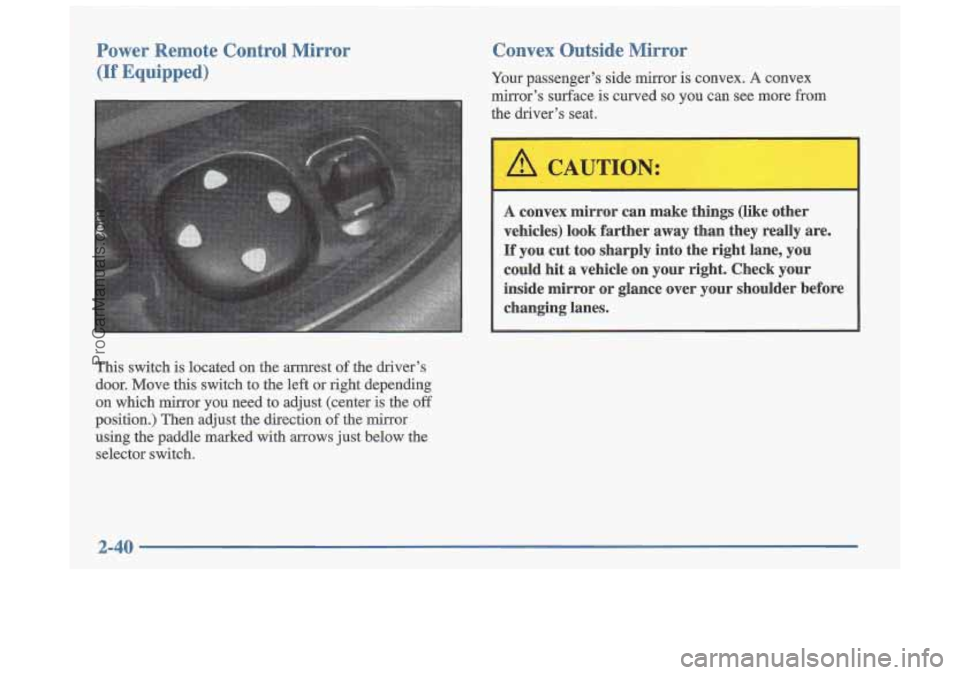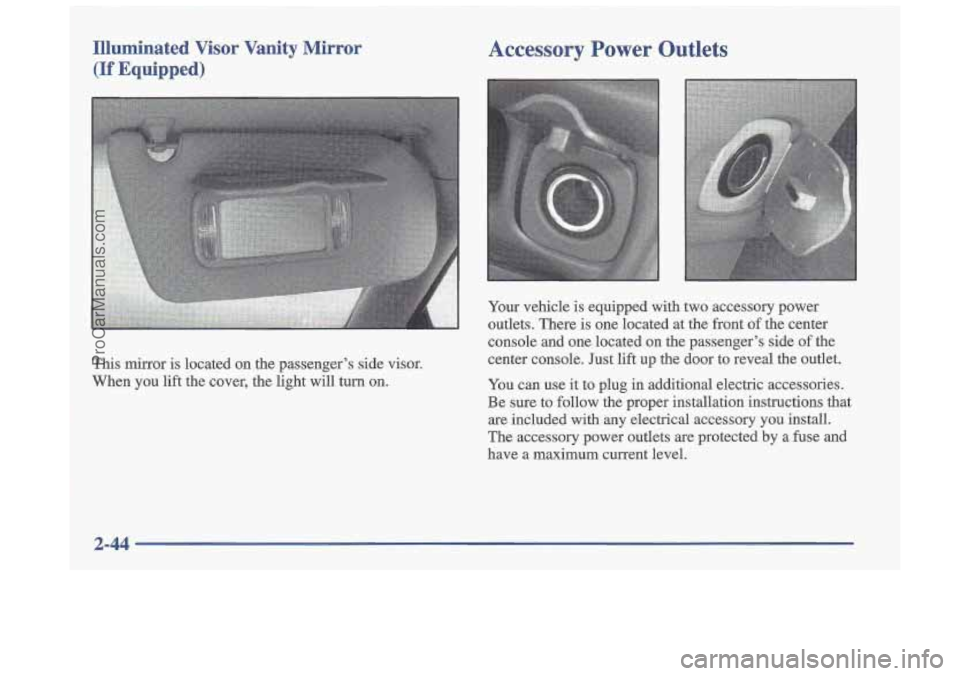1997 OLDSMOBILE CUTLASS mirror
[x] Cancel search: mirrorPage 58 of 353

Section 2 Features and Controls
2-3
2-4
2-5
2-6
2-8
2-11
2-13
2-13
2- 14
2-
15
2- 17
2-2
1
2-21
2-25
2-26
Here
you can learn about the many standard and optional features on your Oldsmobile, and infomation on starting,
shifting and braking.
Also explained are the instrument panel and the warning systems that tell you if everything is
working properly
-- and what to do if you have a problem.
Important Information About Keys
Door Locks Operation of Child Security Locks
Remote Lock Control
Battery Replacement for Remote
Lock Control
Preventing Theft of Your Vehicle
New Vehicle “Break-In”
Ignition Positions
Tips on Starting Your Engine
Using the Engine Coolant Heater
Automatic Transaxle Operation
Second-Gear Start
Parking Brake Guidelines Important Information on Engine Exhaust
Operation of Your Windows 2-27
2-28
2-29
2-30
2-32
2-35
2-36
2- 37
2-39
2-41
2-45
2-46
2-50 Adjusting
the Tilt Steering Wheel
Functions of the Multifunction Lever
How to Use the High/Low-Beam
Headlamp Changer
Windshield Wipers and Fluid Using Cruise Control
Exterior Lamps
Daytime Running Lamps (Dm) and
Automatic Light Control
(ALC)
Interior Lamps
Rearview Mirrors Storage Compartments
Sunroof
Instrument Panel Overview
All About Your Warning Lights and Gages
2-1
~
ProCarManuals.com
Page 95 of 353

Illuminated EntryLExit System
When you lift the outside handle of either front door, or
open either rear door, the lamps inside your vehicle will
go on. These lamps will fade out after about
40 seconds,
or when the ignition is turned on after all doors have
been closed.
If the ignition was recently turned off, the
lamps will fade out after four seconds. These lamps
will also go on when you press the LOCK or
UNLOCK
button on the optional Remote Lock Control transmitter.
If the ignition has been off for less than two minutes,
the lamps inside your vehicle will stay on for about
15 seconds after your key is removed from the
ignition to provide an illuminated exit.
Mirror Reading Lamps
Press the switch on the lower front portion of the mirror
to turn on the lamp. Press the other side
of the switch to
turn the lamp off.
Three-Position Dome Lamp
The switch on this lamp has three positions. The ON
position will turn on the light. The DOOR position will
turn on the light whenever a door is opened. The OFF
position will shut off the lamp completely, even when
a door is opened.
Trunk Lamp
The trunk lamp comes on when you open your trunk.
Battery Saver
Your Oldsmobile is equipped with a battery saver
feature designed to protect your vehicle’s battery.
When any interior lamp
(trunk, reading, footwell or
glove box) is left on when the~ignition is turned
off, the
battery saver system will automatically shut the lamp
off
after 20 minutes. This will avoid draining the battery.
To reactivate the interior lamps, either:
The ignition must be turned on,
The activated lamp switch must be turned off and
then on or
0 A front door must be opened.
The battery saver feature will also be activated when
any door
of your vehicle is left open.
ProCarManuals.com
Page 96 of 353

Mirrors
Inside Daymight Rearview Mirror
This mirror can be adjusted two ways. First, to adjust
the angle of the mirror, move the mirror to a position
that allows you see out the back window.
To adjust the
height of the mirror, adjust the
arm that connects the
mirror to the windshield.
To reduce glare from lights behind you, move the lever
toward you
to the night position.
Manual Remote Control Mirror
The outside rearview mirror should be adjusted so you
can just see the side
of your vehicle when you are sitting
in a comfortable driving position.
Adjust the driver’s side
outside mirror with the
control lever on the
driver’s door.
To adjust your passenger’s side mirror, sit in the driver’s
seat and have a passenger adjust the mirror for you.
2-39
ProCarManuals.com
Page 97 of 353

Convex Outside Mirror Power Remote Control Mirror
(If Equipped) Your passenger’s side mirror is convex. A convex
mirror’s surface is curved so you can see more from
the driver’s seat.
A convex mirror can make things (like other
vehicles) look farther away than they really are.
If you cut too sharply into the right lane, you could hit a vehicle on your right. Check your
inside mirror or glance over your shoulder before changing lanes.
This switch is located on the armrest of the driver’s
door. Move this switch to the left or right depending
on which mirror you need to adjust (center is the
off
position.) Then adjust the direction of the mirror
using the paddle marked with arrows just below the
selector switch.
2-40
ProCarManuals.com
Page 100 of 353

Convenience Net (If Equipped)
Your vehicle may have a convenience net. You'll see it
just inside the back wall of the trunk.
Put small loads, like grocery bags, behind the net. It can
help keep them from falling over during sharp
turns or
quick starts and stops.
The net isn't for larger, heavier loads. Store them in the
trunk as far forward as you can.
You can unhook the net so that it will lie flat when
you're not using it.
Sunvisors
To block out glare, you can swing down the visors. You
can also swing them to the side.
-Esor Vanity Mirror
Lift the cover to expose the visor vanity mirror.
~~ 2-43
ProCarManuals.com
Page 101 of 353

Illuminated Visor Vanity Mirror Accessory Power Outlets
(If Equipped)
This mirror is located on the passenger’s side visor.
When you lift the cover, the light will turn
on.
Your vehicle is equipped with two accessory power
outlets. There is one located at the front of the center
console and one located on the passenger’s side of the
center console. Just lift up the door to reveal the outlet.
You can use it to plug in additional electric accessories.
Be sure to follow the proper installation instructions that
are included with any electrical accessory you install.
The accessory power outlets
are protected by a fuse and
have a maximum current level.
2-44
ProCarManuals.com
Page 158 of 353

0
0
0
0
Check your mirrors, glance over your shoulder, and start your left lane change signal before moving out
of the right lane to pass. When you are far enough
ahead of the passed vehicle to see its front in your
inside mirror, activate your right lane change signal
and move back into the right lane. (Remember that
your right outside mirror is convex. The vehicle you
just passed may seem to be farther away from you
than it really is.)
Try not to pass more than one vehicle at a time on
two-lane roads. Reconsider before passing the
next vehicle.
Don’t overtake a slowly moving vehicle too rapidly.
Even though the brake lamps are not flashing, it may
be slowing down or starting to
turn.
If you’re being passed, make
following driver to get ahead
can ease a little to the right. it easy
for the
of you. Perhaps
you
Loss of Control
Let’s review what driving experts say about what
happens when the three control systems (brakes, steering
and acceleration) don’t have enough friction where the
tires meet the road
to do what the driver has asked.
In any emergency, don’t give up. Keep trying to steer and
constantly seek
an escape route or area of less danger.
Skidding
In a skid, a driver can lose control of the vehicle.
Defensive drivers avoid most skids by taking reasonable
care suited to existing conditions, and by not “overdriving”\
those conditions. But skids are always possible.
The three types
of skids correspond to your
Oldsmobile’s three control systems. In the braking
skid,
your wheels aren’t rolling. In the steering or cornering
skid, too much speed or steering
in a curve causes tires
to slip and lose cornering force. And in the acceleration
skid, too much throttle causes the driving wheels to spin.
4-13
ProCarManuals.com
Page 159 of 353

If your vehicle starts to slide, ease your foot off the
accelerator pedal and quickly steer the way you want the
vehicle to
go. If you start steering quickly enough, your
vehicle may straighten out. Always be ready for a
second skid if it occurs.
Of course, traction
is reduced when water, snow, ice,
gravel or other material is on the road. For safety, you’ll
want
to slow down and adjust your driving to these
conditions. It is important to slow down on slippery
surfaces because stopping distance will be longer and
vehicle control more limited.
While driving
on a surface with reduced traction, try
your best to avoid sudden steering, acceleration or
braking (including engine braking by shifting to a lower gear). Any sudden changes could cause the tires to slide.
You may not realize the surface
is slippery until your
vehicle
is skidding. Learn to recognize warning clues --
such as enough water, ice or packed snow on the road to
make a “mirrored surface”
-- and slow down when you
have any doubt.
Remember: Any anti-lock brake system
(ABS) helps
avoid only the braking skid.
Driving at Night
I
Night driving is more dangerous than day driving. One
reason is that some drivers are likely to
be impaired - by
alcohol or drugs, with night
vision problems, or by fatigue.
4-14
ProCarManuals.com